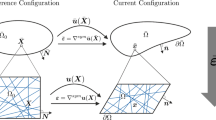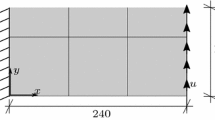Abstract
This contribution deals with a computational model for a shape memory alloy fiber composite. Three main topics have been considered within the presented model. First, a 1D fiber model is derived which accounts for all relevant nonlinear material phenomena of shape memory alloys. These are pseudoelasticity in the high temperature range and pseudoplasticity in the low temperature range. The latter is closely connected to the shape memory effect. The constrained and two-way shape memory effect are captured as well. Second, the shape memory fiber model is implemented into the finite element method. Two different structural elements are derived which lead to two different discretization schemes. A non-conform meshing concept and a conform meshing concept are presented. Randomly oriented and distributed fibers are considered. Both schemes are compared within the paper. Third, an \(\hbox {FE}^{2}\) ansatz is presented. The computational homogenization process makes the detailed description of the complicated fiber-structure on macro-level dispensable. The micro-structure is considered in a representative volume element. It captures the main characteristics of the multi-functional composite. Finally, numerical examples present the capability of the formulation.
























Similar content being viewed by others
References
McCormick J, DesRoches R, Fugazza D, Auricchio F (2006) Seismic vibration control using superelastic shape memory alloys. J Eng Mater-T ASME 128:294
Castellano M, Colato G, Infanti S (2004) Use of viscous dampers and shock transmission units in the seismic protection of buildings. In: Proceedings of 13th world conference on earthquake engineering, pp. 1–15. Paper No. 2172
Indirli M, Castellano M, Clemente P, Martelli A (2001) Demo-application of shape memory alloy devices: the rehabilitation of the S. Giorgio Church bell tower. In: Liu SC (ed) Smart structures and materials 2001: Smart systems for bridges, structures, and highways, society of photo-optical instrumentation engineers (SPIE) conference series, vol 4330, Society of photo-optical instrumentation engineers (SPIE) conference series, vol 4330, pp. 262–272
Indirli M, Spadoni B, Carni R, Clemente C, Martelli A, Castellano M (2008) Shape memory alloy devices for the structural improvement of masonry heritage structures. Int J Archit Herit 2:93
Song G, Ma N, Li HN (2006) Applications of shape memory alloys in civil structures. Eng Struct 28:1266
Moser K, Bergamini A, Christen R, Czaderski C (2005) Feasibility of concrete prestressed by shape memory alloy short fibers. Mater Struct 38:593
Janke L, Czaderski C, Motavalli M, Ruth J (2005) Formgedächtnislegierungen in Ingenieurstrukturen des Stahlbetonbaues: Materialphänomene, Anwendungskonzepte und Visionen. Mater Struct 38(279):578
Klinkel S, Kohlhaas B (2011) Modellierung und Anwendung von Formgedächtnislegierungen im Bauwesen. Bauingenieur-germany Jahresausgabe 2011/2012:101
Achenbach M, Müller I (1982) A model for shape memory. J Phys Paris 43(C4):163
Seelecke S, Müller I (2004) Shape memory alloy actuators in smart structures: modeling and simulation. Appl Mech Rev 57:23
Brinson L (1993) One-dimensional behavior of shape memory alloys: thermomechanical derivation with non-constant material functions and redefined martensite internal variable. J Intel Mater Syst Struct 4:229
Leclercq S, Lexcellent C (1996) A general macroscopic description of the thermomechanical behavior of shape memory alloys. J Mech Phys Solids 44(6):953
Raniecki B, Lexcellent C (1998) Thermodynamics of isotropic pseudoelasticity in shape memory alloys. Eur J Mech A Solid 17:185
Bo Z, Lagoudas D (1999) Thermomechanical modeling of polycrystalline {SMAs} under cyclic loading, Part I: theoretical derivations. Int J Eng Sci 37(9):1089
Lagoudas D, Bo Z (1999) Thermomechanical modeling of polycrystalline {SMAs} under cyclic loading, Part II: material characterization and experimental results for a stable transformation cycle. Int J Eng Sci 37(9):1141
Bo Z, Lagoudas D (1999) Thermomechanical modeling of polycrystalline {SMAs} under cyclic loading, Part III: evolution of plastic strains and two-way shape memory effect. Int J Eng Sci 37(9):1175
Bo Z, Lagoudas D (1999) Thermomechanical modeling of polycrystalline {SMAs} under cyclic loading, Part IV: modeling of minor hysteresis loops. Int J Eng Sci 37(9):1205
Helm D (2001) Formgedächtnislegierungen: experimentelle Untersuchung, phänomenologische Modellierung und numerische Simulation der thermomechanischen Materialeigenschaften. Ph.D. thesis, Universität Gesamthochschule Kassel
Helm D, Haupt P (2003) Shape memory behaviour: modelling within continuum thermomechanics. Int J Solids Struct 40:827
Helm D (2007) Numerical simulation of martensititc phase transitions in shape memory alloys using an improved integration algorithm. Int J Numer Methods Eng 69:1997
Helm D (2007) Thermomechanics of martensititc phase transformations in shape memory alloys – I. Constitutive theories for small and large deformations. J Mech Mater Struct 2:87
Christ D, Reese S (2008) Thermomechanically coupled modelling of shape memory alloys in the framework of large strains. GAMM-Mitteilungen 31(2):176
Christ D, Reese S (2009) A finite element model for shape memory alloys considering thermomechanical couplings at large strains. Int J Solids Struct 46:3694
Christ D (2009) Thermomechanical modelling of shape memory alloy structures in medical applications. Ph.D. thesis, Technische Universität Braunschweig
Lagoudas D (2008) Shape memory alloys: modeling and engineering applications. Springer, Boston
Evangelista V, Marfia S, Sacco E (2009) Phenomenological 3D and 1D consistent models for shape-memory alloy materials. Comput Mech 44(3):405
Khandan R, Mahzoon M, Fazelzadeh S, Ali H (2009) A consistent approach for deriving a 1D constitutive equation for shape memory alloys. Smart Mater Struct 18(9):1
Aboudi J, Freed Y (2006) Two-way thermomechanically coupled micromechanical analysis of shape memory alloy composites. J Mech 1:937
Armstrong W, Kino H (1995) Martensitic transformations in a NiTi fiber reinforced 6061 aluminium matrix composite. J Intel Mater Syst Struct 6:809
Boyd J, Lagoudas D (1996) A thermodynamical constitutive model for shape memory materials—Part I: The monolithic shape memory alloy. Int J Plast 12(7):843
Carvelli V, Taliercio A (1999) A micromechanical model for the analysis of unidirectional elastoplastic composites subjected to 3D stresses. Mech Res Commun 26(5):547
Cherkaoui M, Sun Q, Song G (2000) MIcromechanics modeling of composite with ductile matrix and shape memory alloy reinforcement. Int J Solids Struct 37:1577
Notta-Cuvier D, Lauro F, Bennani B, Balieu R (2013) An efficient modelling of inelastic composites with misaligned short fibres. Int J Solids Struct 50:2857
Freed Y, Aboudi J (2008) Micromechanical investigation of plasticity-damage coupling of concrete reinforced by shape memory alloy fibers. Smart Mater Struct 17:1
Gilat R, Aboudi J (2004) Dynamic response of active composite plates: shape memory fibers in polymeric/metallic matrices. Int J Solids Struct 41:5717
Kawai M, Ogawa H, Baburaj V, Koga T (1999) Micromechanical analysis for hysteretic behavior of unidirectional TiNi SMA fiber composites. J Intel Mater Syst Struct 10:14
Klinkel S, Sansour C, Wagner W (2005) An anisotropic fibre-matrix material model at finite elastic–plastic strains. Comput Mech 35:409
Marfia S (2005) Micro-macro analysis of shape memory alloy composites. Int J Solids Struct 42:3677
Song G, Cherkaoui M, Sun Q (1999) Role of microstructure in the thermomechanical behavior of SMA composites. J Eng Mater-T ASME 121(1):86
Gebbeken N (1996) Zur Untersuchung des linearen Tragverhaltens von Verbundkonstruktionen mittels numerischer Methoden. Technical Report 96/1, Universität der Bundeswehr München
Huber F (2006) Nichtlineare dreidimensionale Modellierung von Beton- und Stahlbetontragwerken. Ph.D. thesis, Universität Stuttgart
Miehe C, Schröder J, Schotte J (1999) Computational homogenization analysis in finite plasticity simulation of texture development in polycrystalline materials. Comput Method Appl Mech 171(3–4):387
Geers M, Coenen E, Kouznetsova V (2007) Multi-scale computational homogenization of structured thin sheets. Model Simul Mater Sci 15(4):S393
Oskay C, Fish J (2007) Eigendeformation-based reduced order homogenization for failure analysis of heterogeneous materials. Comput Method Appl Mech 196(7):1216
Gruttmann F, Wagner W (2013) A coupled two-scale shell model with applications to layered structures. Int J Numer Method Eng 94(13):1233
Simo J, Hughes T (2000) Computational inelasticity, interdisciplinary applied mathematics mechanics and materials, vol 7. Springer, New York
Neunzert H, Blickensdörfer-Ehlers A (1998) Analysis, 3rd edn. Springer, Berlin
Juhász L (2004) Herleitung eines konstitutiven Modells für Formgedächtnislegierungen. Ph.D. thesis, Universität Karlsruhe
Zohdi T, Wriggers P (2005) Introduction To computational micromechanics. Lecture Notes in applied and computational mechanics. Springer Verlag, Berlin Heidelberg
Hill R (1963) Elastic properties of reinforced solids: some theoretical principles. J Mech Phys Solids 11(5):357
Gross D, Seelig T (2001) Bruchmechanik: Mit einer Einführung in die Mikromechanik. Springer, Berlin. URL http://www.books.google.de/books?id=ySI3E0YoEMQC
Author information
Authors and Affiliations
Corresponding author
Rights and permissions
About this article
Cite this article
Kohlhaas, B., Klinkel, S. An \(\hbox {FE}^{2}\) model for the analysis of shape memory alloy fiber-composites. Comput Mech 55, 421–437 (2015). https://doi.org/10.1007/s00466-014-1112-3
Received:
Accepted:
Published:
Issue Date:
DOI: https://doi.org/10.1007/s00466-014-1112-3




